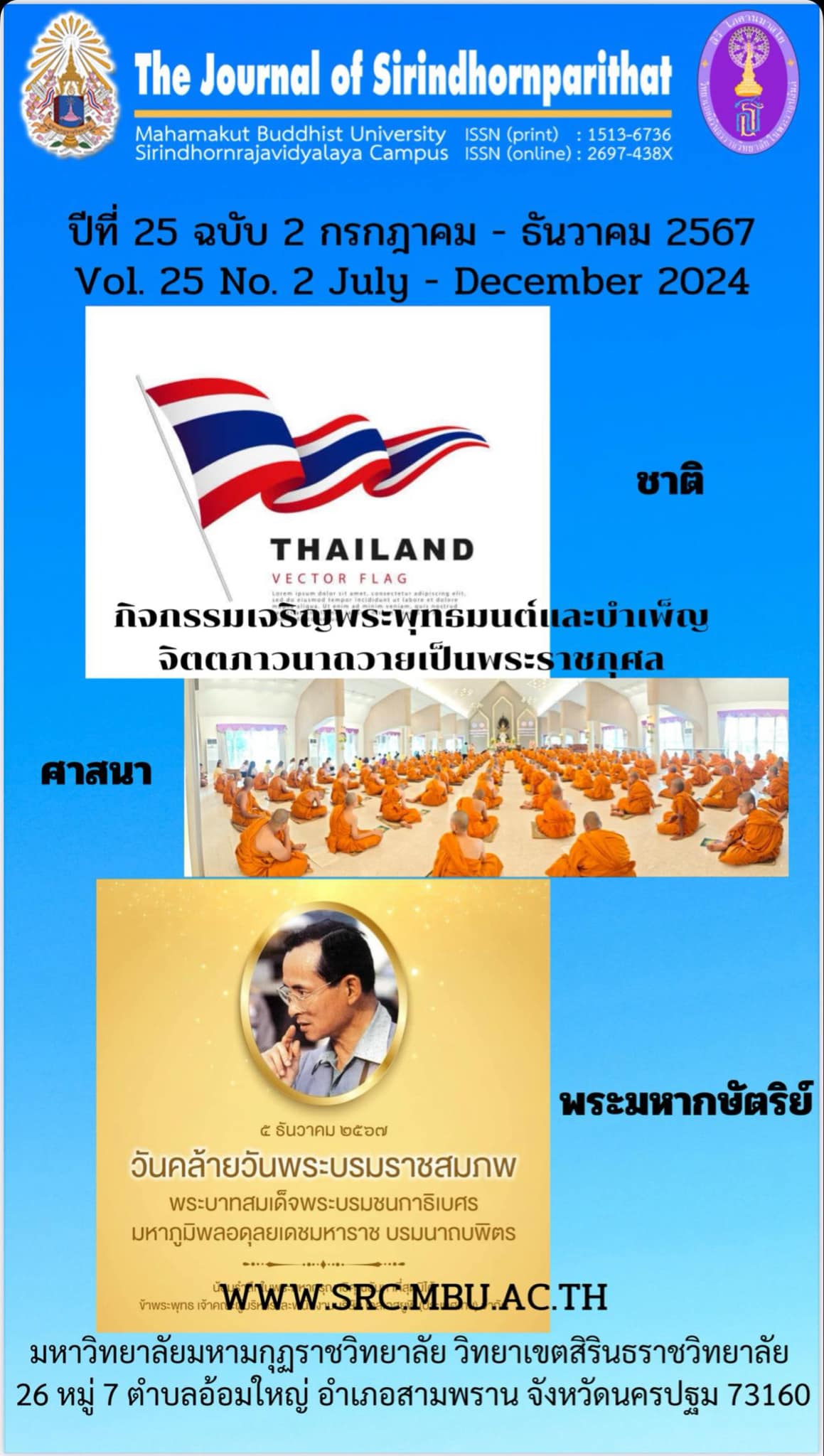A Management Model According To Aparihãniyadhamma On Network Of Professional Learning Community
Keywords:
According to Management, Professional Learning Community, APARIHÃNIYADHAMMAAbstract
The objectives of this research paper were 1) to study the conditions of academic administration in a professional learning community network, 2) to create a model of academic administration in a professional learning community network according to the principle, and 3) to assess the model of academic administration on the professional learning community network in terms of correctness, suitability, feasibility, and helpful. According to the supernatural principles, this research applied a mixed research methodology (Exploratory Sequential Mixed Methods Design) that consisted of quantitative research and qualitative research methods by collecting data in a triangular way (Methodological Triangulation), including interviewing the target group (Target Group Interview) of 9 people, and survey research of 400 copies to calculate the mean, standard deviation (SD), percentage, and model analysis to develop a model.
The results of the research were as follows; 1) The current situation of academic administration on the professional learning community network was generally at a high level with an average of 4.23. The highest score was teaching and learning at 4.32, followed by curriculum development. The highest average score was 4.26 while the lowest average score was 4.26. For example, the measurement and evaluation had a score of 4.10. 2) Academic administration model on the network of professional learning community according to the APARIHÃNIYADHAMMA principles which consisted of 15 aspects; 1. Curriculum development on supportive leadership, 2. Curriculum development with the target of APARIHÃNIYADHAMMA learning, 3. Curriculum development about member corporations, 4. Curriculum development about discussion and reflection at APARIHÃNIYADHAMMA, 5. Curriculum development about the openness of learning on each other according to APARIHÃNIYADHAMMA’s principles, 6. Teaching about supportive leadership and sharing of leadership according to the APARIHÃNIYADHAMMA’s principle, 7. The aspect of teaching and learning about having the same target of learners according to the APARIHÃNIYADHAMMA 8. The aspect of teaching and learning about the cooperation of members according to the APARIHÃNIYADHAMMA principles. 9. Teaching and learning about talking and reflecting as the APARIHÃNIYADHAMMA’s principles, 10. Teaching and learning about accepting learning on APARIHÃNIYADHAMMA’s principles, 11. Measurement and evaluation of supportive leadership and sharing leadership according to the supernatural principles, 12. Measurement and evaluation of setting the same target as learners according to the APARIHÃNIYADHAMMA, 13. Measurement and evaluation concerning the cooperation of members according to the APARIHÃNIYADHAMMA 14. Measurement aspect, 15. Measuring and evaluating the acceptance of learning from each other according to the APARIHÃNIYADHAMMA. 3) The results of academic administration model on the network of professional learning community according to the APARIHÃNIYADHAMMA principles ,the overall picture of the 15 aspects was correctness, appropriateness, and usefulness , were at the highest average level. and possibility The average is at a high level.
References
กองวิชาการ มหาวิทยาลัยธรรมกาย แคลิฟอร์เนีย. (2555). พุทธธรรม 2. ปทุมธานี: มหาวิทยาลัยธรรมกาย แคลิฟอร์เนีย.
นวลลออ พลรักษา. (2561). โมเดลสมการโครงสร้างปัจจัยที่มีอิทธิพลต่อการเป็นชุมชนแห่งการเรียนรู้ทางวิชาชีพสำหรับสถานศึกษาขั้นพื้นฐาน. ดุษฎีนิพนธ์ปรัชญาดุษฎีบัณฑิต. มหาวิทยาลัยขอนแก่น.
บุญชอบ จันทาพูน และคณะ. (2561). กลยุทธ์การเสริมสร้างชุมชนแห่งการเรียนรู้ทางวิชาชีพสำหรับครูโรงเรียนเทศบาล 1 ต้นยาง จังหวัดเชียงราย. วารสารวิจัยและพัฒนาวไลยอลงกรณ์ในพระบรมราชูปถัมภ์. 2(13). 17-27
พระพรหมคุณาภรณ์ (ป.อ. ปยุตฺโต). (2550). ธรรมนูญชีวิต. กรุงเทพมหานคร : สำนักพิมพ์จันทร์เพ็ญ.
พัชรา แย้มสาราญ. (2559). กระบวนทัศน์การพัฒนาวิชาชีพครูเพื่อส่งเสริมทักษะชีวิตและอาชีพในศตวรรษที่ 21 ของนักเรียนระดับมัธยมศึกษาตอนต้น. ดุษฎีนิพนธ์ครุศาสตรดุษฎีบัณฑิต. มหาวิทยาลัยศิลปากร.
มินตรา ลายสนิทเสรีกุล. (2561). กลยุทธ์การบริหารโรงเรียนมัธยมศึกษาตามแนวคิดชุมชนแห่งการเรียนรู้ทางวิชาชีพ ความไว้วางใจของคณะครู และคุณภาพของผลลัพธ์ทางการศึกษา. ดุษฎีนิพนธ์ครุศาสตรดุษฎีบัณฑิต. จุฬาลงกรณ์มหาวิทยาลัย.
รัสวดี ควรทรงธรรม. (2562). นวัตกรรมการบริหารโรงเรียนมัธยมศึกษาเอกชนตามแนวคิดคุณภาพจากภายใน. ดุษฎีนิพนธ์ครุศาสตรดุษฎีบัณฑิต. จุฬาลงกรณ์มหาวิทยาลัย.
เรวณี ชัยเชาวรัตน์. (2558).กระบวนการเสริมสร้างความสามารถในการออกแบบการเรียนการสอนของนักศึกษาปฏิบัติการวิชาชีพครูตามแนวคิดชุมชนการเรียนรู้ทางวิชาชีพ: การวิจัยกรณีศึกษา. ดุษฎีนิพนธ์ครุศาสตรดุษฎีบัณฑิต.จุฬาลงกรณ์มหาวิทยาลัย.
สายสุนีย์ กอสนาน. (2562). ชุมชนการเรียนรู้เชิงวิชาชีพโดยผสมผสานเครือข่ายสังคมเพื่อเสริมสร้างสมรรถนะการจัดการเรียนรู้แบบไตร่ตรองที่ส่งเสริมความสามารถในการคิดวิเคราะห์ของนักเรียนระดับประถมศึกษา. ดุษฎีนิพนธ์ครุศาสตรดุษฎีบัณฑิต. มหาวิทยาลัยศิลปากร.
สำนักงานเลขาธิการสภาการศึกษา. (2560) แผนการศึกษาแห่งชาติ พ.ศ.2560-2579. กรุงเทพมหานคร: พริกหวานกราฟฟิค.
สำนักพัฒนาครูและบุคลากรทางการศึกษา. คู่มือประกอบการอบรมการขับเคลื่อนกระบวนการ PLC (Professional Learning Community) “ชุมชนการเรียนรู้ทางวิชาชีพ” สู่สถานศึกษา. แหล่งที่มา: http://www.thaischool1.in.th/_files_school/94010001/data/94010001
_1_20210916-124154.pdf สืบค้นเมื่อ 1 พฤษภาคม 2564.
สุวิมล สพฤกษ์ศรี. (2561). ชุมชนการเรียนรู้วิชาชีพโดยผสมผสานเทคโนโลยีเพื่อเสริมสร้างสมรรถนะการจัดการเรียนรู้โดยใช้ศิลปะเป็นฐานที่ส่งเสริมความสามารถในการสร้างสรรค์นวัตกรรมของนักเรียนระดับประถมศึกษา. ดุษฎีนิพนธ์ครุศาสตรดุษฎีบัณฑิต. มหาวิทยาลัยศิลปากร.
อนุสรา สุวรรณวงศ์. (2558). กลยุทธ์การบริหารเพื่อเสริมสร้างชุมชนแห่งการเรียนรู้ทางวิชาชีพสำหรับครูโรงเรียนเอกชน. ดุษฎีนิพนธ์ครุศาสตรดุษฎีบัณฑิต. จุฬาลงกรณ์มหาวิทยาลัย.
Downloads
Published
Issue
Section
License
Copyright (c) 2024 Mahamakut Buddhist University

This work is licensed under a Creative Commons Attribution-NonCommercial-NoDerivatives 4.0 International License.
บทความที่ได้รับการตีพิมพ์เป็นลิขสิทธิ์ของ มหาวิทยาลัยมหามกุฏราชวิทยาลัย วิทยาเขตสิรินธรราชวิทยาลัย
ข้อความที่ปรากฏในบทความแต่ละเรื่องในวารสารวิชาการเล่มนี้เป็นความคิดเห็นส่วนตัวของผู้เขียนแต่ละท่านไม่เกี่ยวข้องกับหาวิทยาลัยมหามกุฏราชวิทยาลัย วิทยาเขตสิรินธรราชวิทยาลัย และคณาจารย์ท่านอื่นๆในมหาวิทยาลัยฯ แต่อย่างใด ความรับผิดชอบองค์ประกอบทั้งหมดของบทความแต่ละเรื่องเป็นของผู้เขียนแต่ละท่าน หากมีความผิดพลาดใดๆ ผู้เขียนแต่ละท่านจะรับผิดชอบบทความของตนเองแต่ผู้เดียว




